Analysis of Woolworths Group Financial Performance: HC2091, Finance 1
VerifiedAdded on 2023/06/07
|18
|3785
|217
Report
AI Summary
This report provides a comprehensive financial analysis of Woolworths Group Limited, examining its performance through various financial ratios. The analysis includes the calculation and interpretation of liquidity, leverage, efficiency, profitability, and market value ratios for the years 2016 and 2017. The report also investigates share price movements, comparing Woolworths' performance with the All Ordinaries Index. Furthermore, the report utilizes the constant dividend growth rate model to estimate the company's stock value and compare it with the market price. The findings highlight the company's financial strengths and weaknesses, offering insights into its overall financial health and providing a basis for informed decision-making. The report concludes with a summary of the key findings and recommendations based on the financial evaluation.
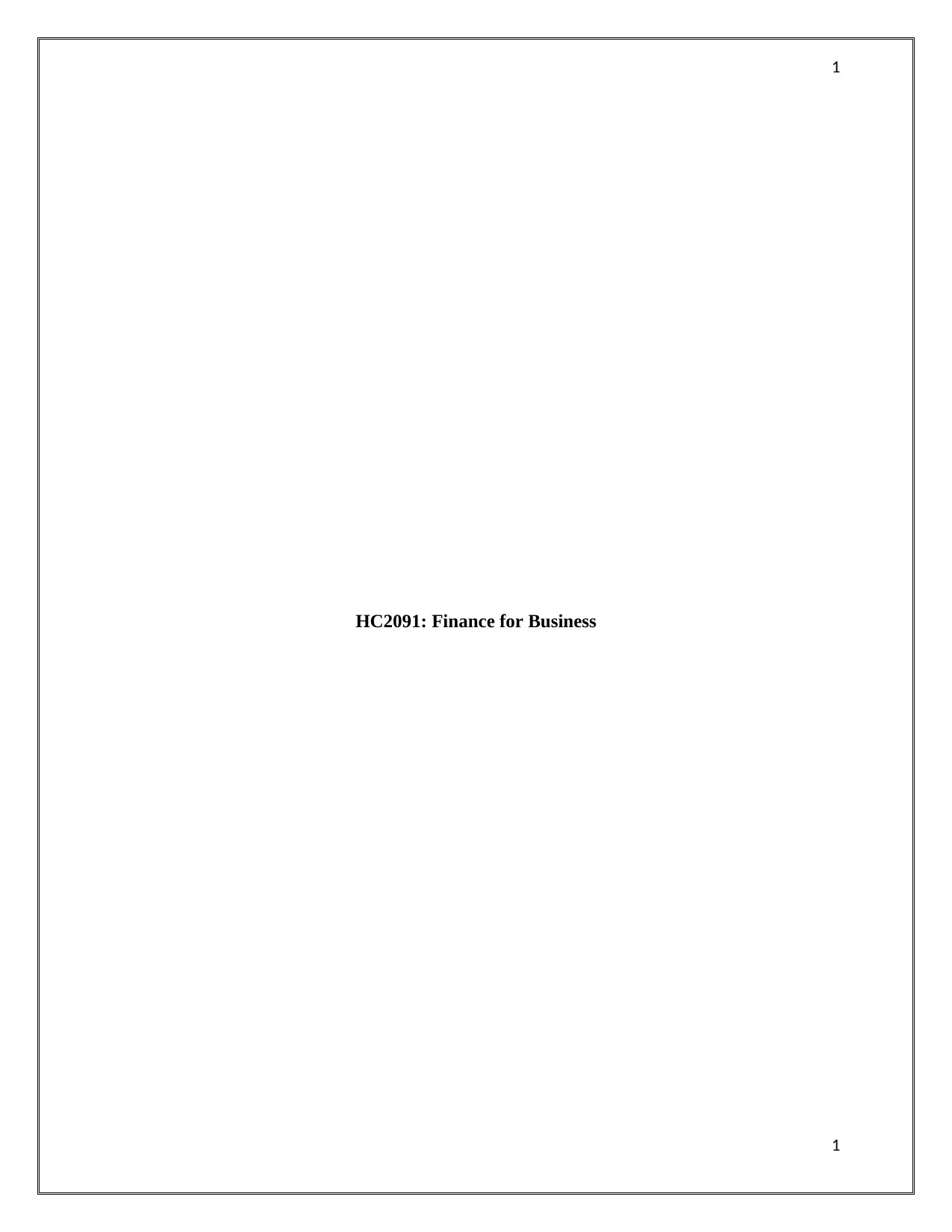
1
HC2091: Finance for Business
1
HC2091: Finance for Business
1
Paraphrase This Document
Need a fresh take? Get an instant paraphrase of this document with our AI Paraphraser
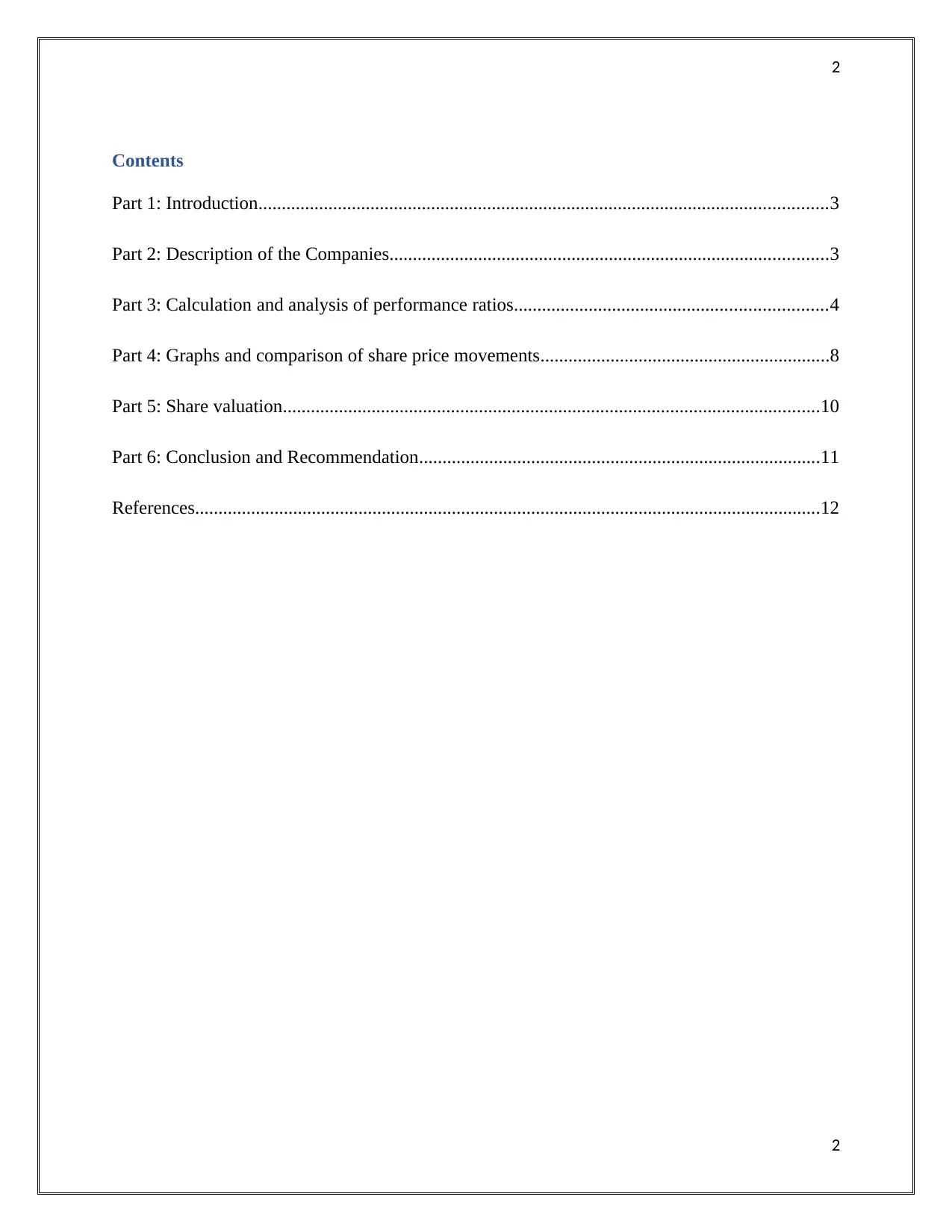
2
Contents
Part 1: Introduction..........................................................................................................................3
Part 2: Description of the Companies..............................................................................................3
Part 3: Calculation and analysis of performance ratios...................................................................4
Part 4: Graphs and comparison of share price movements..............................................................8
Part 5: Share valuation...................................................................................................................10
Part 6: Conclusion and Recommendation......................................................................................11
References......................................................................................................................................12
2
Contents
Part 1: Introduction..........................................................................................................................3
Part 2: Description of the Companies..............................................................................................3
Part 3: Calculation and analysis of performance ratios...................................................................4
Part 4: Graphs and comparison of share price movements..............................................................8
Part 5: Share valuation...................................................................................................................10
Part 6: Conclusion and Recommendation......................................................................................11
References......................................................................................................................................12
2
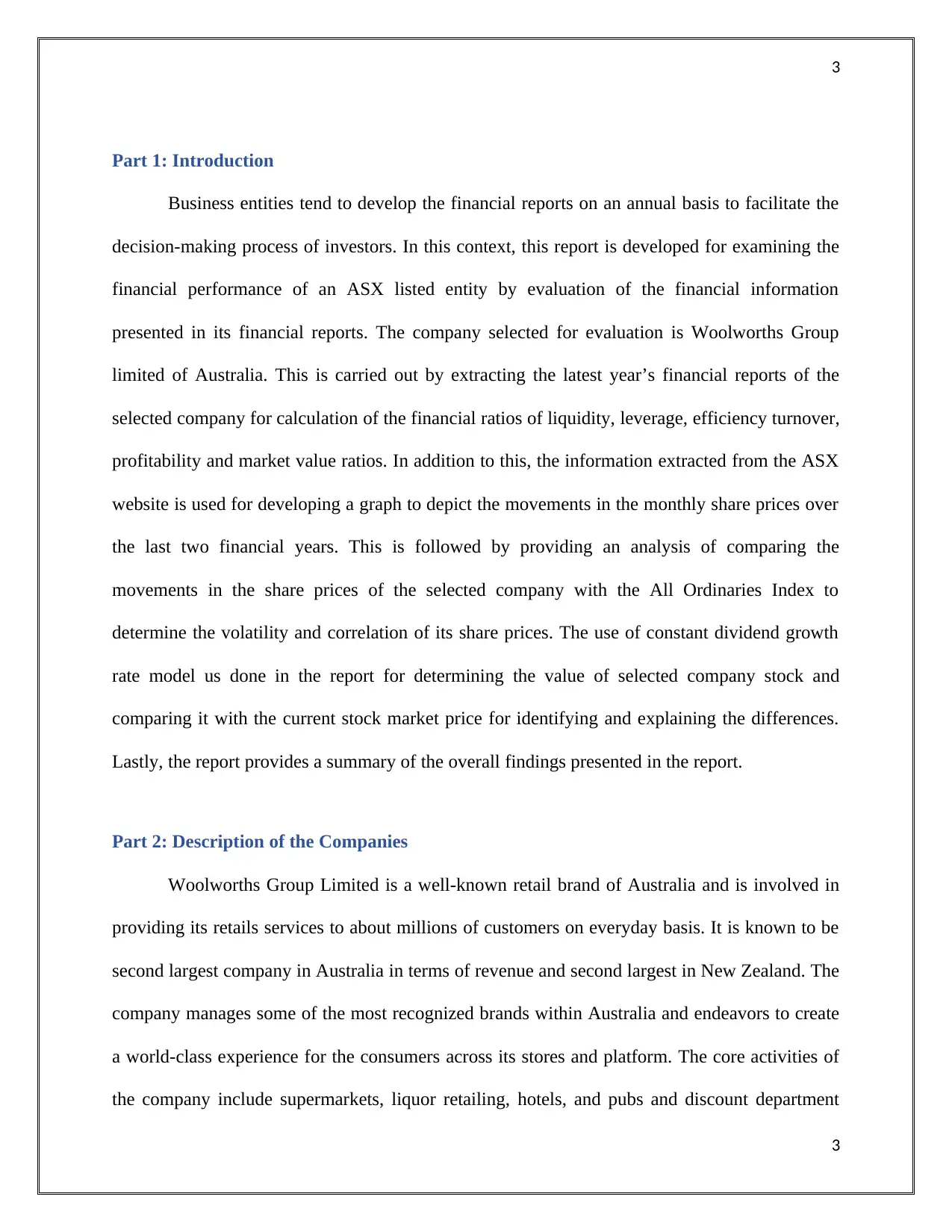
3
Part 1: Introduction
Business entities tend to develop the financial reports on an annual basis to facilitate the
decision-making process of investors. In this context, this report is developed for examining the
financial performance of an ASX listed entity by evaluation of the financial information
presented in its financial reports. The company selected for evaluation is Woolworths Group
limited of Australia. This is carried out by extracting the latest year’s financial reports of the
selected company for calculation of the financial ratios of liquidity, leverage, efficiency turnover,
profitability and market value ratios. In addition to this, the information extracted from the ASX
website is used for developing a graph to depict the movements in the monthly share prices over
the last two financial years. This is followed by providing an analysis of comparing the
movements in the share prices of the selected company with the All Ordinaries Index to
determine the volatility and correlation of its share prices. The use of constant dividend growth
rate model us done in the report for determining the value of selected company stock and
comparing it with the current stock market price for identifying and explaining the differences.
Lastly, the report provides a summary of the overall findings presented in the report.
Part 2: Description of the Companies
Woolworths Group Limited is a well-known retail brand of Australia and is involved in
providing its retails services to about millions of customers on everyday basis. It is known to be
second largest company in Australia in terms of revenue and second largest in New Zealand. The
company manages some of the most recognized brands within Australia and endeavors to create
a world-class experience for the consumers across its stores and platform. The core activities of
the company include supermarkets, liquor retailing, hotels, and pubs and discount department
3
Part 1: Introduction
Business entities tend to develop the financial reports on an annual basis to facilitate the
decision-making process of investors. In this context, this report is developed for examining the
financial performance of an ASX listed entity by evaluation of the financial information
presented in its financial reports. The company selected for evaluation is Woolworths Group
limited of Australia. This is carried out by extracting the latest year’s financial reports of the
selected company for calculation of the financial ratios of liquidity, leverage, efficiency turnover,
profitability and market value ratios. In addition to this, the information extracted from the ASX
website is used for developing a graph to depict the movements in the monthly share prices over
the last two financial years. This is followed by providing an analysis of comparing the
movements in the share prices of the selected company with the All Ordinaries Index to
determine the volatility and correlation of its share prices. The use of constant dividend growth
rate model us done in the report for determining the value of selected company stock and
comparing it with the current stock market price for identifying and explaining the differences.
Lastly, the report provides a summary of the overall findings presented in the report.
Part 2: Description of the Companies
Woolworths Group Limited is a well-known retail brand of Australia and is involved in
providing its retails services to about millions of customers on everyday basis. It is known to be
second largest company in Australia in terms of revenue and second largest in New Zealand. The
company manages some of the most recognized brands within Australia and endeavors to create
a world-class experience for the consumers across its stores and platform. The core activities of
the company include supermarkets, liquor retailing, hotels, and pubs and discount department
3
⊘ This is a preview!⊘
Do you want full access?
Subscribe today to unlock all pages.

Trusted by 1+ million students worldwide
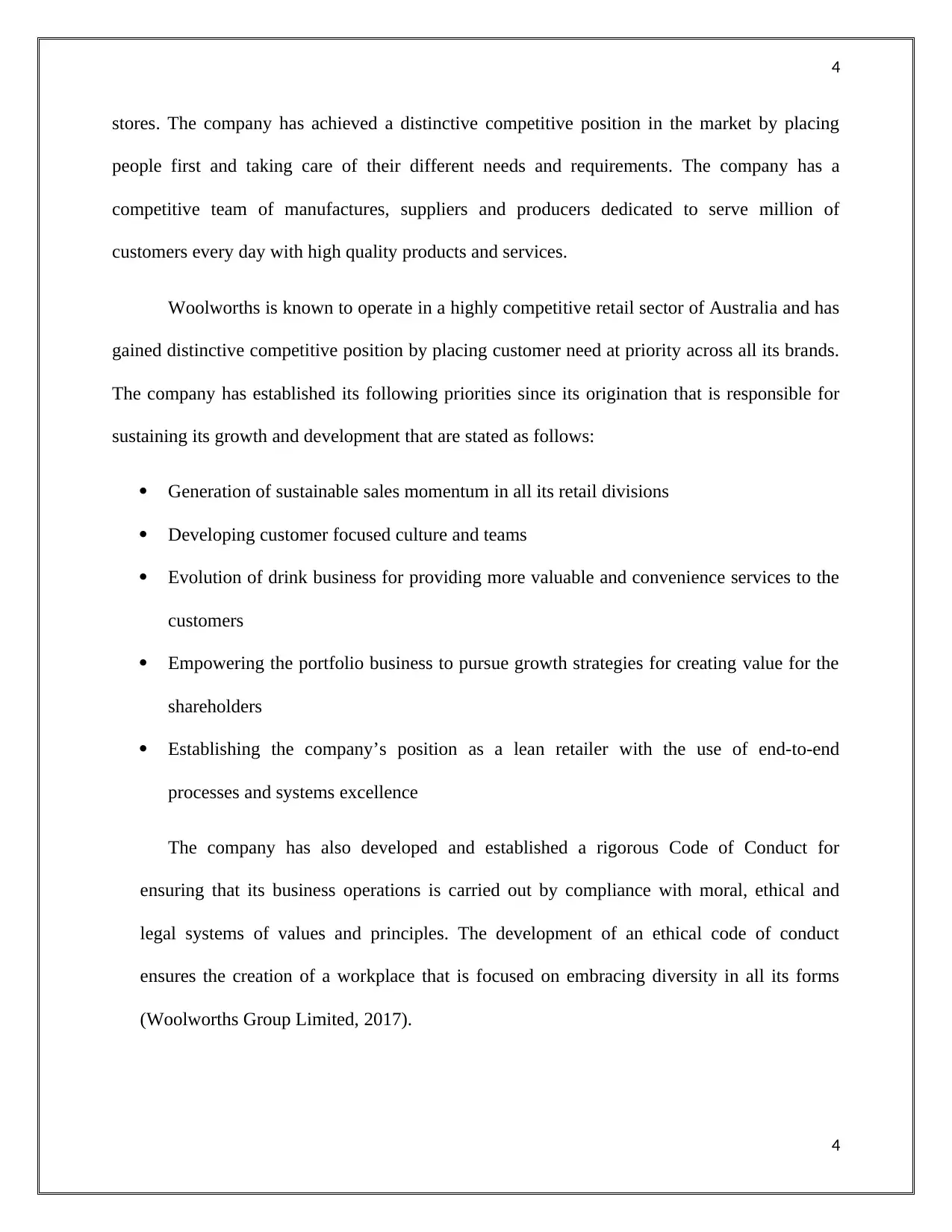
4
stores. The company has achieved a distinctive competitive position in the market by placing
people first and taking care of their different needs and requirements. The company has a
competitive team of manufactures, suppliers and producers dedicated to serve million of
customers every day with high quality products and services.
Woolworths is known to operate in a highly competitive retail sector of Australia and has
gained distinctive competitive position by placing customer need at priority across all its brands.
The company has established its following priorities since its origination that is responsible for
sustaining its growth and development that are stated as follows:
Generation of sustainable sales momentum in all its retail divisions
Developing customer focused culture and teams
Evolution of drink business for providing more valuable and convenience services to the
customers
Empowering the portfolio business to pursue growth strategies for creating value for the
shareholders
Establishing the company’s position as a lean retailer with the use of end-to-end
processes and systems excellence
The company has also developed and established a rigorous Code of Conduct for
ensuring that its business operations is carried out by compliance with moral, ethical and
legal systems of values and principles. The development of an ethical code of conduct
ensures the creation of a workplace that is focused on embracing diversity in all its forms
(Woolworths Group Limited, 2017).
4
stores. The company has achieved a distinctive competitive position in the market by placing
people first and taking care of their different needs and requirements. The company has a
competitive team of manufactures, suppliers and producers dedicated to serve million of
customers every day with high quality products and services.
Woolworths is known to operate in a highly competitive retail sector of Australia and has
gained distinctive competitive position by placing customer need at priority across all its brands.
The company has established its following priorities since its origination that is responsible for
sustaining its growth and development that are stated as follows:
Generation of sustainable sales momentum in all its retail divisions
Developing customer focused culture and teams
Evolution of drink business for providing more valuable and convenience services to the
customers
Empowering the portfolio business to pursue growth strategies for creating value for the
shareholders
Establishing the company’s position as a lean retailer with the use of end-to-end
processes and systems excellence
The company has also developed and established a rigorous Code of Conduct for
ensuring that its business operations is carried out by compliance with moral, ethical and
legal systems of values and principles. The development of an ethical code of conduct
ensures the creation of a workplace that is focused on embracing diversity in all its forms
(Woolworths Group Limited, 2017).
4
Paraphrase This Document
Need a fresh take? Get an instant paraphrase of this document with our AI Paraphraser
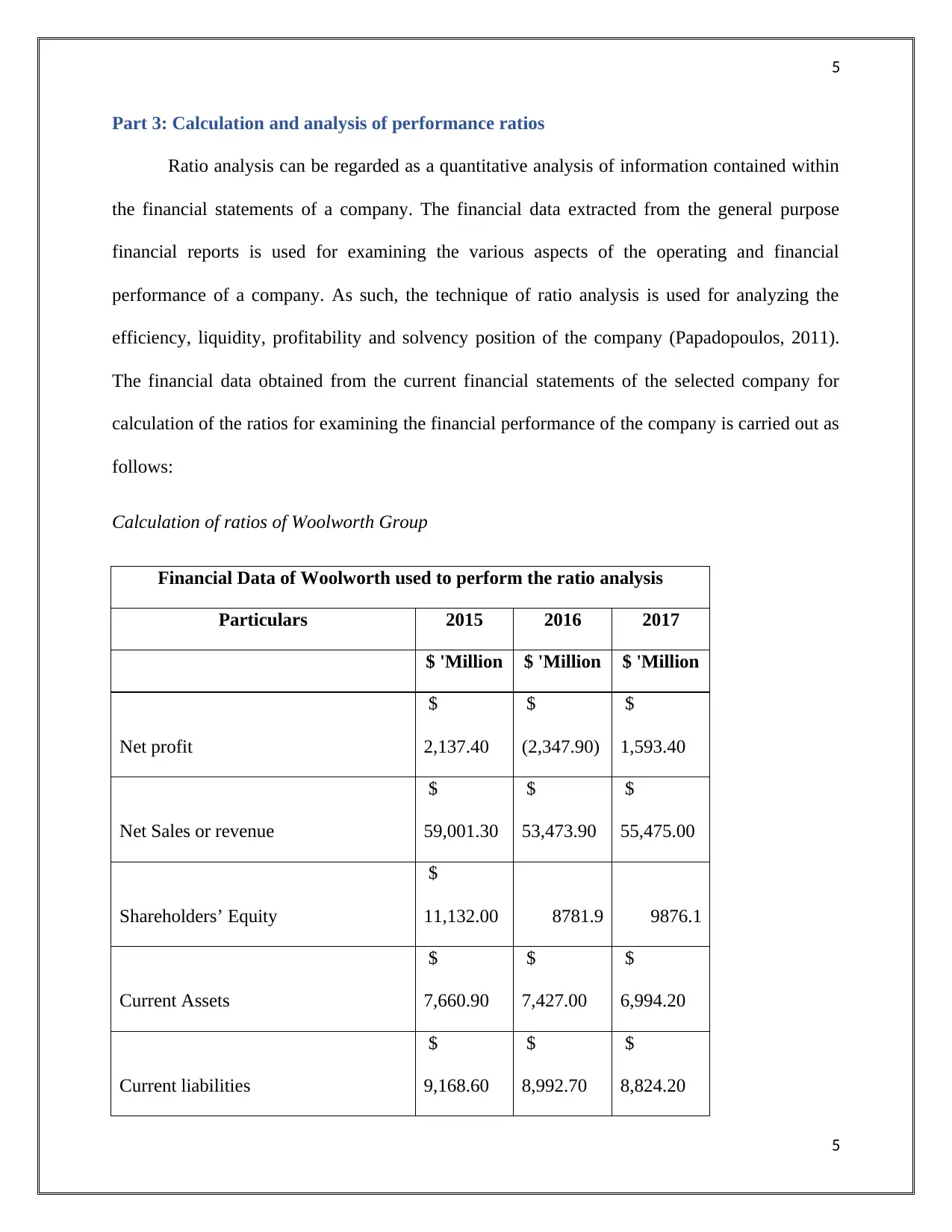
5
Part 3: Calculation and analysis of performance ratios
Ratio analysis can be regarded as a quantitative analysis of information contained within
the financial statements of a company. The financial data extracted from the general purpose
financial reports is used for examining the various aspects of the operating and financial
performance of a company. As such, the technique of ratio analysis is used for analyzing the
efficiency, liquidity, profitability and solvency position of the company (Papadopoulos, 2011).
The financial data obtained from the current financial statements of the selected company for
calculation of the ratios for examining the financial performance of the company is carried out as
follows:
Calculation of ratios of Woolworth Group
Financial Data of Woolworth used to perform the ratio analysis
Particulars 2015 2016 2017
$ 'Million $ 'Million $ 'Million
Net profit
$
2,137.40
$
(2,347.90)
$
1,593.40
Net Sales or revenue
$
59,001.30
$
53,473.90
$
55,475.00
Shareholders’ Equity
$
11,132.00 8781.9 9876.1
Current Assets
$
7,660.90
$
7,427.00
$
6,994.20
Current liabilities
$
9,168.60
$
8,992.70
$
8,824.20
5
Part 3: Calculation and analysis of performance ratios
Ratio analysis can be regarded as a quantitative analysis of information contained within
the financial statements of a company. The financial data extracted from the general purpose
financial reports is used for examining the various aspects of the operating and financial
performance of a company. As such, the technique of ratio analysis is used for analyzing the
efficiency, liquidity, profitability and solvency position of the company (Papadopoulos, 2011).
The financial data obtained from the current financial statements of the selected company for
calculation of the ratios for examining the financial performance of the company is carried out as
follows:
Calculation of ratios of Woolworth Group
Financial Data of Woolworth used to perform the ratio analysis
Particulars 2015 2016 2017
$ 'Million $ 'Million $ 'Million
Net profit
$
2,137.40
$
(2,347.90)
$
1,593.40
Net Sales or revenue
$
59,001.30
$
53,473.90
$
55,475.00
Shareholders’ Equity
$
11,132.00 8781.9 9876.1
Current Assets
$
7,660.90
$
7,427.00
$
6,994.20
Current liabilities
$
9,168.60
$
8,992.70
$
8,824.20
5

6
Inventory
$
4,872.20
$
4,558.50
$
4,080.40
Quick Assets
$
2,788.70
$
2,868.50
$
2,913.80
Total Liabilities
$
14,204.80
$
14,720.30
$
13,039.70
Total Assets
$
25,336.80
$
23,502.20
$
22,915.80
Account receivable
$
885.20
$
763.90
$
744.70
Average accounts receivable
$
824.55
$
754.30
Cost of goods sold
$
42,950.90
$
38,538.60
$
39,739.70
Average Inventory
$
4,715.35
$
4,319.45
Profit attributable to equity
shareholders
$
(1,234.80)
$
1,533.50
Number of Equity Shares
$
1,263.50
$
1,283.90
(Annual Report, 2017 and Annual Report, 2016)
Calculation of Financial Ratios
Ratios Formula 2016 2017
6
Inventory
$
4,872.20
$
4,558.50
$
4,080.40
Quick Assets
$
2,788.70
$
2,868.50
$
2,913.80
Total Liabilities
$
14,204.80
$
14,720.30
$
13,039.70
Total Assets
$
25,336.80
$
23,502.20
$
22,915.80
Account receivable
$
885.20
$
763.90
$
744.70
Average accounts receivable
$
824.55
$
754.30
Cost of goods sold
$
42,950.90
$
38,538.60
$
39,739.70
Average Inventory
$
4,715.35
$
4,319.45
Profit attributable to equity
shareholders
$
(1,234.80)
$
1,533.50
Number of Equity Shares
$
1,263.50
$
1,283.90
(Annual Report, 2017 and Annual Report, 2016)
Calculation of Financial Ratios
Ratios Formula 2016 2017
6
⊘ This is a preview!⊘
Do you want full access?
Subscribe today to unlock all pages.

Trusted by 1+ million students worldwide
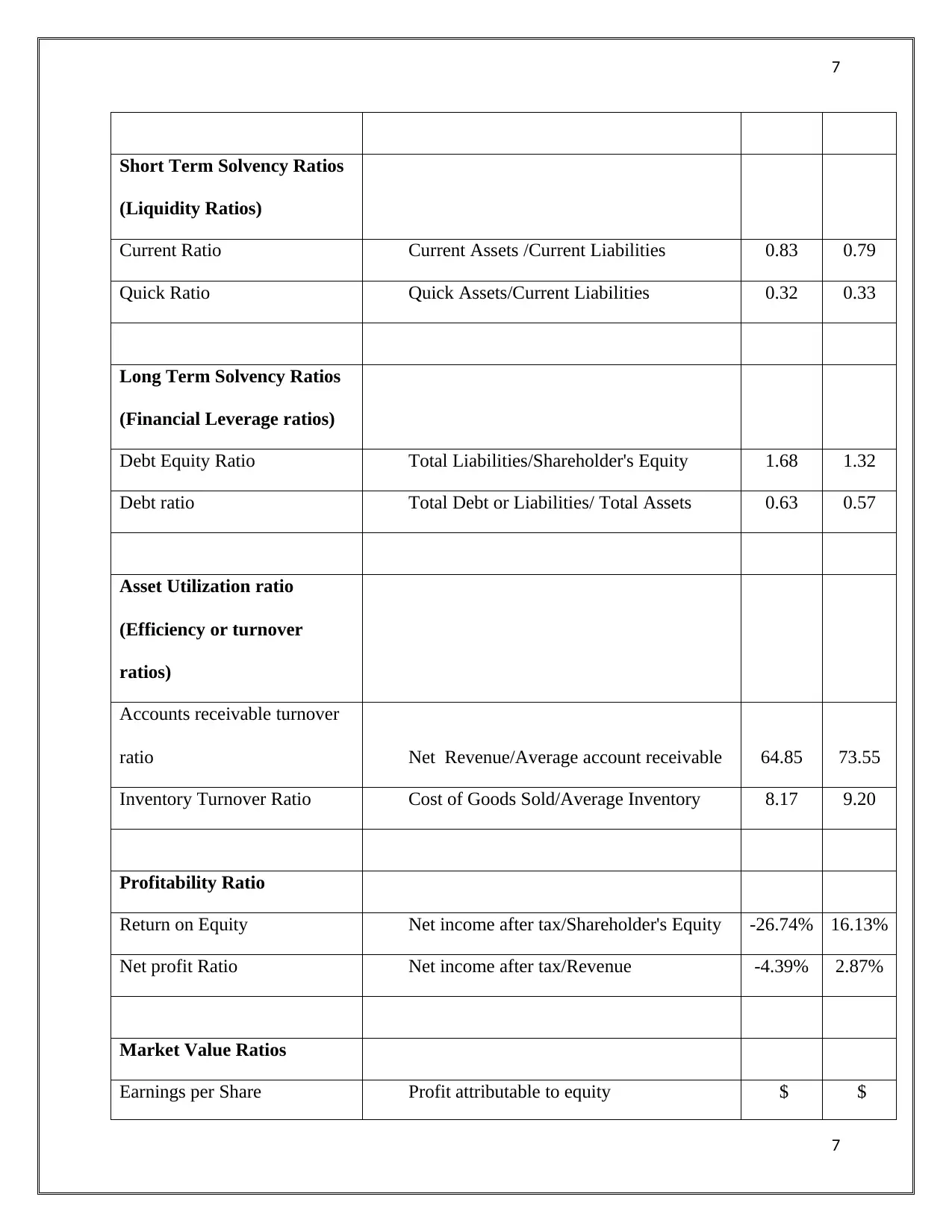
7
Short Term Solvency Ratios
(Liquidity Ratios)
Current Ratio Current Assets /Current Liabilities 0.83 0.79
Quick Ratio Quick Assets/Current Liabilities 0.32 0.33
Long Term Solvency Ratios
(Financial Leverage ratios)
Debt Equity Ratio Total Liabilities/Shareholder's Equity 1.68 1.32
Debt ratio Total Debt or Liabilities/ Total Assets 0.63 0.57
Asset Utilization ratio
(Efficiency or turnover
ratios)
Accounts receivable turnover
ratio Net Revenue/Average account receivable 64.85 73.55
Inventory Turnover Ratio Cost of Goods Sold/Average Inventory 8.17 9.20
Profitability Ratio
Return on Equity Net income after tax/Shareholder's Equity -26.74% 16.13%
Net profit Ratio Net income after tax/Revenue -4.39% 2.87%
Market Value Ratios
Earnings per Share Profit attributable to equity $ $
7
Short Term Solvency Ratios
(Liquidity Ratios)
Current Ratio Current Assets /Current Liabilities 0.83 0.79
Quick Ratio Quick Assets/Current Liabilities 0.32 0.33
Long Term Solvency Ratios
(Financial Leverage ratios)
Debt Equity Ratio Total Liabilities/Shareholder's Equity 1.68 1.32
Debt ratio Total Debt or Liabilities/ Total Assets 0.63 0.57
Asset Utilization ratio
(Efficiency or turnover
ratios)
Accounts receivable turnover
ratio Net Revenue/Average account receivable 64.85 73.55
Inventory Turnover Ratio Cost of Goods Sold/Average Inventory 8.17 9.20
Profitability Ratio
Return on Equity Net income after tax/Shareholder's Equity -26.74% 16.13%
Net profit Ratio Net income after tax/Revenue -4.39% 2.87%
Market Value Ratios
Earnings per Share Profit attributable to equity $ $
7
Paraphrase This Document
Need a fresh take? Get an instant paraphrase of this document with our AI Paraphraser
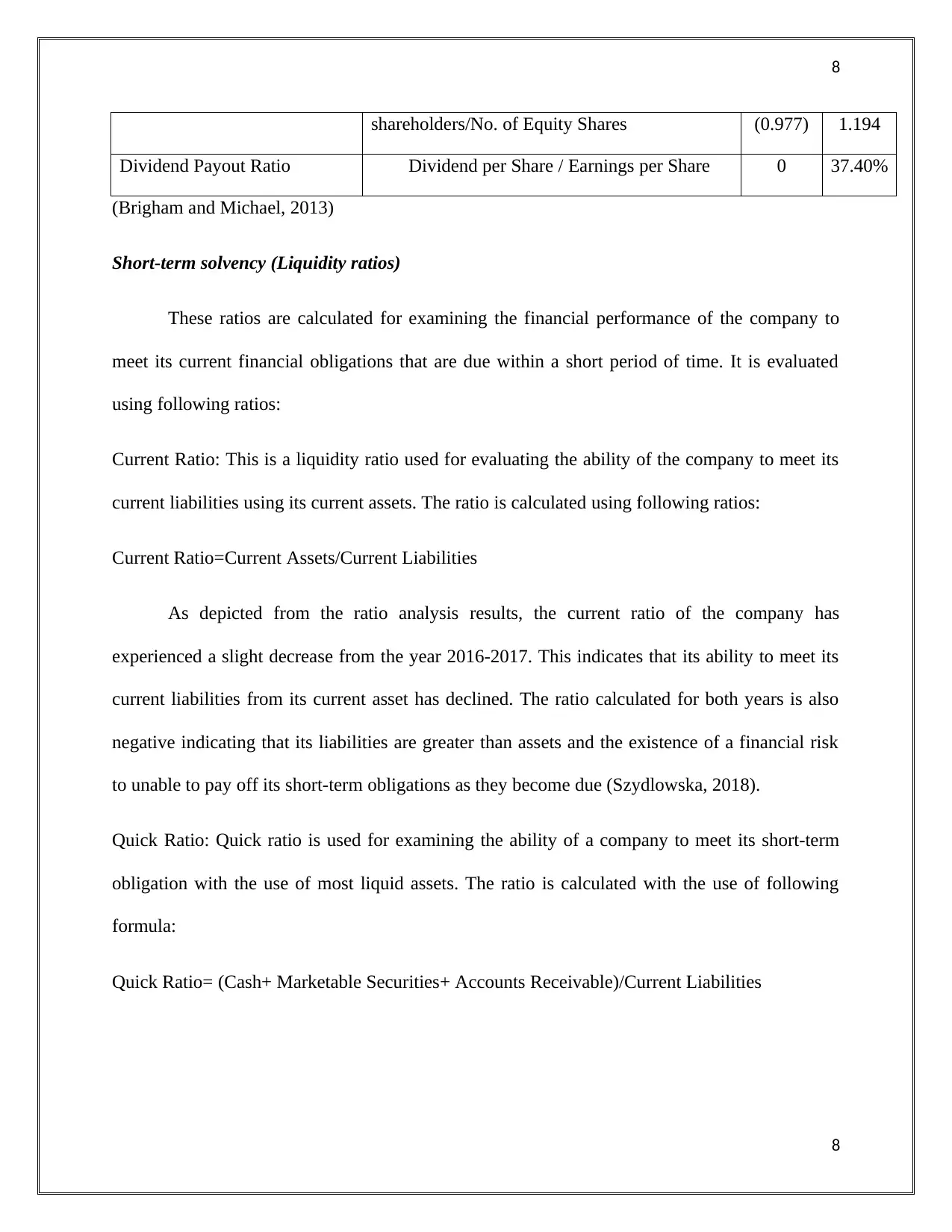
8
shareholders/No. of Equity Shares (0.977) 1.194
Dividend Payout Ratio Dividend per Share / Earnings per Share 0 37.40%
(Brigham and Michael, 2013)
Short-term solvency (Liquidity ratios)
These ratios are calculated for examining the financial performance of the company to
meet its current financial obligations that are due within a short period of time. It is evaluated
using following ratios:
Current Ratio: This is a liquidity ratio used for evaluating the ability of the company to meet its
current liabilities using its current assets. The ratio is calculated using following ratios:
Current Ratio=Current Assets/Current Liabilities
As depicted from the ratio analysis results, the current ratio of the company has
experienced a slight decrease from the year 2016-2017. This indicates that its ability to meet its
current liabilities from its current asset has declined. The ratio calculated for both years is also
negative indicating that its liabilities are greater than assets and the existence of a financial risk
to unable to pay off its short-term obligations as they become due (Szydlowska, 2018).
Quick Ratio: Quick ratio is used for examining the ability of a company to meet its short-term
obligation with the use of most liquid assets. The ratio is calculated with the use of following
formula:
Quick Ratio= (Cash+ Marketable Securities+ Accounts Receivable)/Current Liabilities
8
shareholders/No. of Equity Shares (0.977) 1.194
Dividend Payout Ratio Dividend per Share / Earnings per Share 0 37.40%
(Brigham and Michael, 2013)
Short-term solvency (Liquidity ratios)
These ratios are calculated for examining the financial performance of the company to
meet its current financial obligations that are due within a short period of time. It is evaluated
using following ratios:
Current Ratio: This is a liquidity ratio used for evaluating the ability of the company to meet its
current liabilities using its current assets. The ratio is calculated using following ratios:
Current Ratio=Current Assets/Current Liabilities
As depicted from the ratio analysis results, the current ratio of the company has
experienced a slight decrease from the year 2016-2017. This indicates that its ability to meet its
current liabilities from its current asset has declined. The ratio calculated for both years is also
negative indicating that its liabilities are greater than assets and the existence of a financial risk
to unable to pay off its short-term obligations as they become due (Szydlowska, 2018).
Quick Ratio: Quick ratio is used for examining the ability of a company to meet its short-term
obligation with the use of most liquid assets. The ratio is calculated with the use of following
formula:
Quick Ratio= (Cash+ Marketable Securities+ Accounts Receivable)/Current Liabilities
8
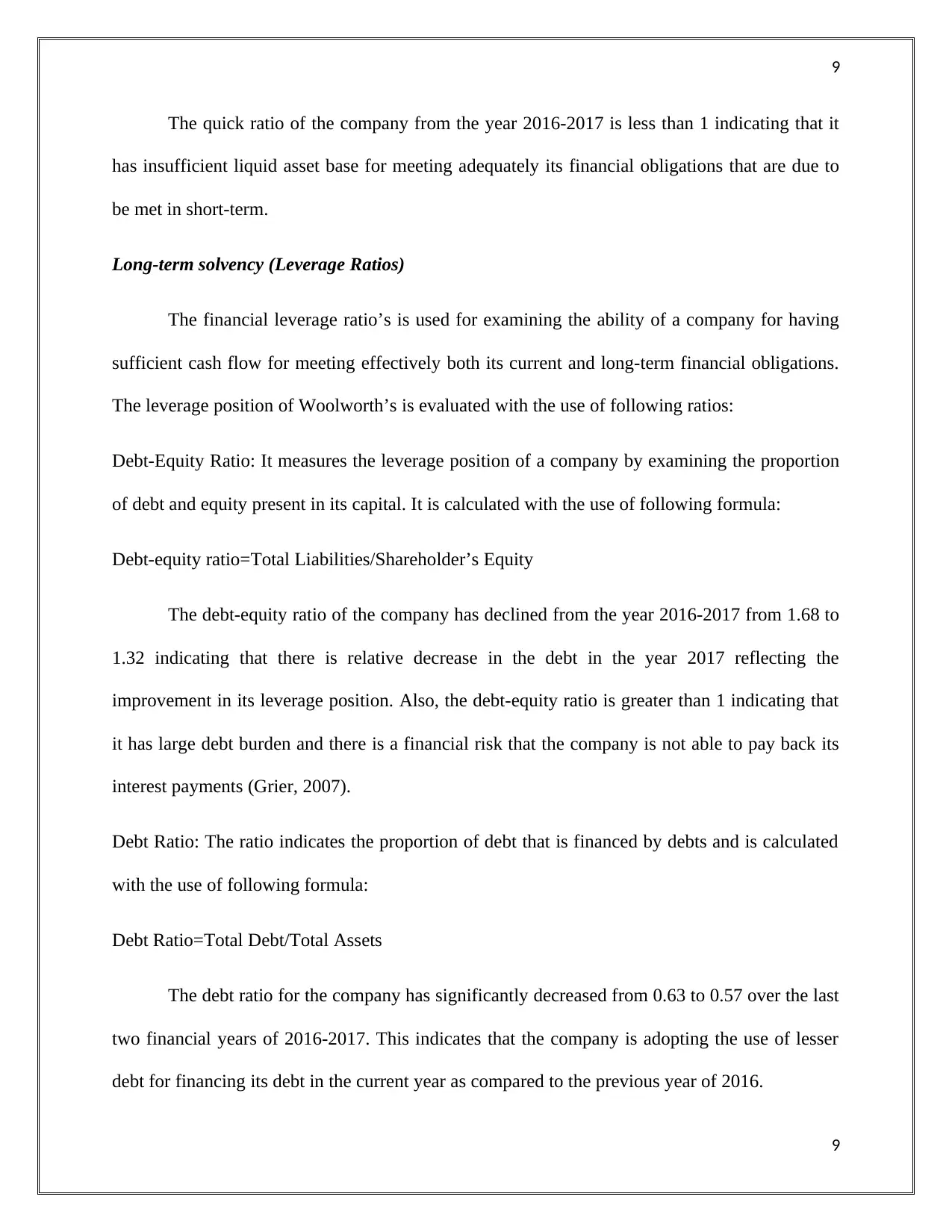
9
The quick ratio of the company from the year 2016-2017 is less than 1 indicating that it
has insufficient liquid asset base for meeting adequately its financial obligations that are due to
be met in short-term.
Long-term solvency (Leverage Ratios)
The financial leverage ratio’s is used for examining the ability of a company for having
sufficient cash flow for meeting effectively both its current and long-term financial obligations.
The leverage position of Woolworth’s is evaluated with the use of following ratios:
Debt-Equity Ratio: It measures the leverage position of a company by examining the proportion
of debt and equity present in its capital. It is calculated with the use of following formula:
Debt-equity ratio=Total Liabilities/Shareholder’s Equity
The debt-equity ratio of the company has declined from the year 2016-2017 from 1.68 to
1.32 indicating that there is relative decrease in the debt in the year 2017 reflecting the
improvement in its leverage position. Also, the debt-equity ratio is greater than 1 indicating that
it has large debt burden and there is a financial risk that the company is not able to pay back its
interest payments (Grier, 2007).
Debt Ratio: The ratio indicates the proportion of debt that is financed by debts and is calculated
with the use of following formula:
Debt Ratio=Total Debt/Total Assets
The debt ratio for the company has significantly decreased from 0.63 to 0.57 over the last
two financial years of 2016-2017. This indicates that the company is adopting the use of lesser
debt for financing its debt in the current year as compared to the previous year of 2016.
9
The quick ratio of the company from the year 2016-2017 is less than 1 indicating that it
has insufficient liquid asset base for meeting adequately its financial obligations that are due to
be met in short-term.
Long-term solvency (Leverage Ratios)
The financial leverage ratio’s is used for examining the ability of a company for having
sufficient cash flow for meeting effectively both its current and long-term financial obligations.
The leverage position of Woolworth’s is evaluated with the use of following ratios:
Debt-Equity Ratio: It measures the leverage position of a company by examining the proportion
of debt and equity present in its capital. It is calculated with the use of following formula:
Debt-equity ratio=Total Liabilities/Shareholder’s Equity
The debt-equity ratio of the company has declined from the year 2016-2017 from 1.68 to
1.32 indicating that there is relative decrease in the debt in the year 2017 reflecting the
improvement in its leverage position. Also, the debt-equity ratio is greater than 1 indicating that
it has large debt burden and there is a financial risk that the company is not able to pay back its
interest payments (Grier, 2007).
Debt Ratio: The ratio indicates the proportion of debt that is financed by debts and is calculated
with the use of following formula:
Debt Ratio=Total Debt/Total Assets
The debt ratio for the company has significantly decreased from 0.63 to 0.57 over the last
two financial years of 2016-2017. This indicates that the company is adopting the use of lesser
debt for financing its debt in the current year as compared to the previous year of 2016.
9
⊘ This is a preview!⊘
Do you want full access?
Subscribe today to unlock all pages.

Trusted by 1+ million students worldwide
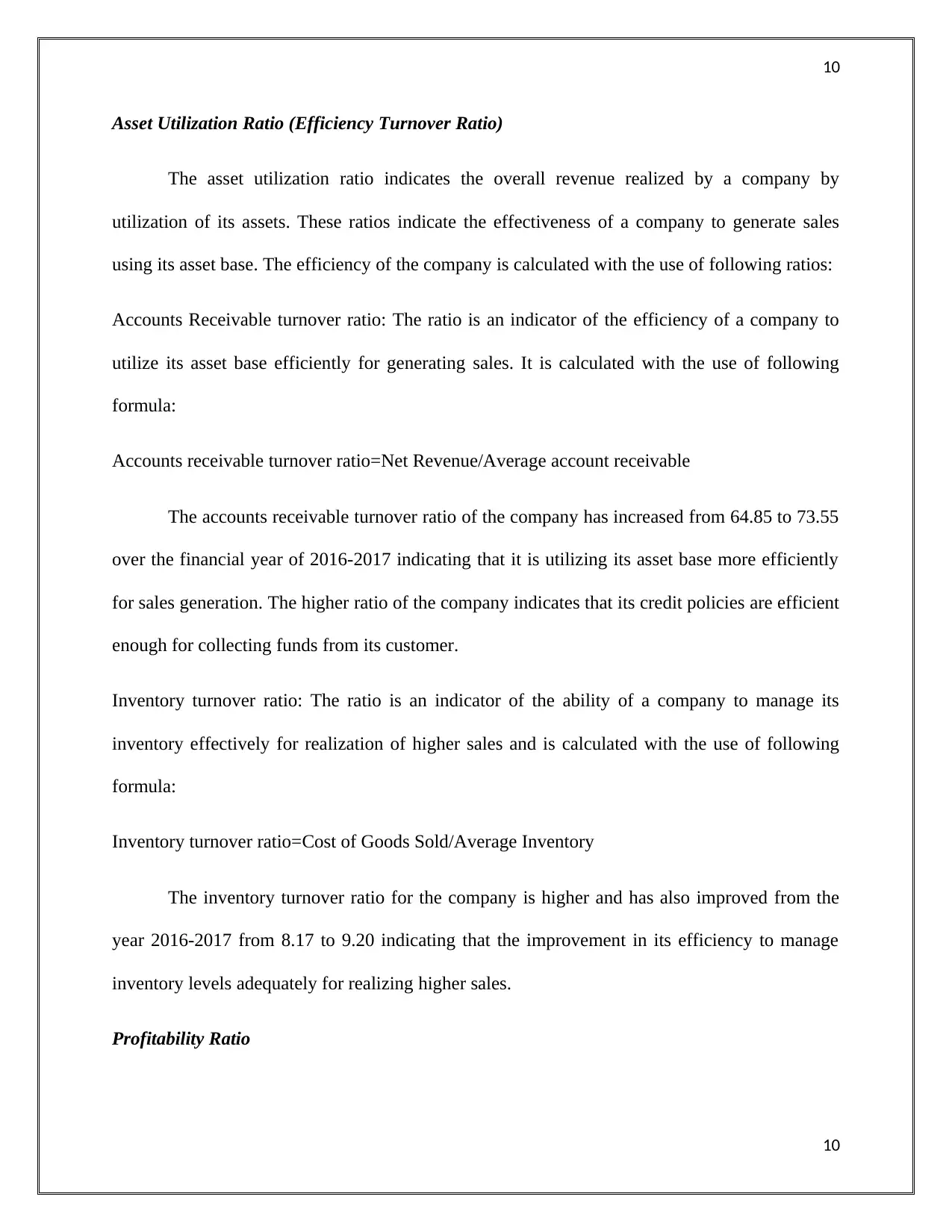
10
Asset Utilization Ratio (Efficiency Turnover Ratio)
The asset utilization ratio indicates the overall revenue realized by a company by
utilization of its assets. These ratios indicate the effectiveness of a company to generate sales
using its asset base. The efficiency of the company is calculated with the use of following ratios:
Accounts Receivable turnover ratio: The ratio is an indicator of the efficiency of a company to
utilize its asset base efficiently for generating sales. It is calculated with the use of following
formula:
Accounts receivable turnover ratio=Net Revenue/Average account receivable
The accounts receivable turnover ratio of the company has increased from 64.85 to 73.55
over the financial year of 2016-2017 indicating that it is utilizing its asset base more efficiently
for sales generation. The higher ratio of the company indicates that its credit policies are efficient
enough for collecting funds from its customer.
Inventory turnover ratio: The ratio is an indicator of the ability of a company to manage its
inventory effectively for realization of higher sales and is calculated with the use of following
formula:
Inventory turnover ratio=Cost of Goods Sold/Average Inventory
The inventory turnover ratio for the company is higher and has also improved from the
year 2016-2017 from 8.17 to 9.20 indicating that the improvement in its efficiency to manage
inventory levels adequately for realizing higher sales.
Profitability Ratio
10
Asset Utilization Ratio (Efficiency Turnover Ratio)
The asset utilization ratio indicates the overall revenue realized by a company by
utilization of its assets. These ratios indicate the effectiveness of a company to generate sales
using its asset base. The efficiency of the company is calculated with the use of following ratios:
Accounts Receivable turnover ratio: The ratio is an indicator of the efficiency of a company to
utilize its asset base efficiently for generating sales. It is calculated with the use of following
formula:
Accounts receivable turnover ratio=Net Revenue/Average account receivable
The accounts receivable turnover ratio of the company has increased from 64.85 to 73.55
over the financial year of 2016-2017 indicating that it is utilizing its asset base more efficiently
for sales generation. The higher ratio of the company indicates that its credit policies are efficient
enough for collecting funds from its customer.
Inventory turnover ratio: The ratio is an indicator of the ability of a company to manage its
inventory effectively for realization of higher sales and is calculated with the use of following
formula:
Inventory turnover ratio=Cost of Goods Sold/Average Inventory
The inventory turnover ratio for the company is higher and has also improved from the
year 2016-2017 from 8.17 to 9.20 indicating that the improvement in its efficiency to manage
inventory levels adequately for realizing higher sales.
Profitability Ratio
10
Paraphrase This Document
Need a fresh take? Get an instant paraphrase of this document with our AI Paraphraser
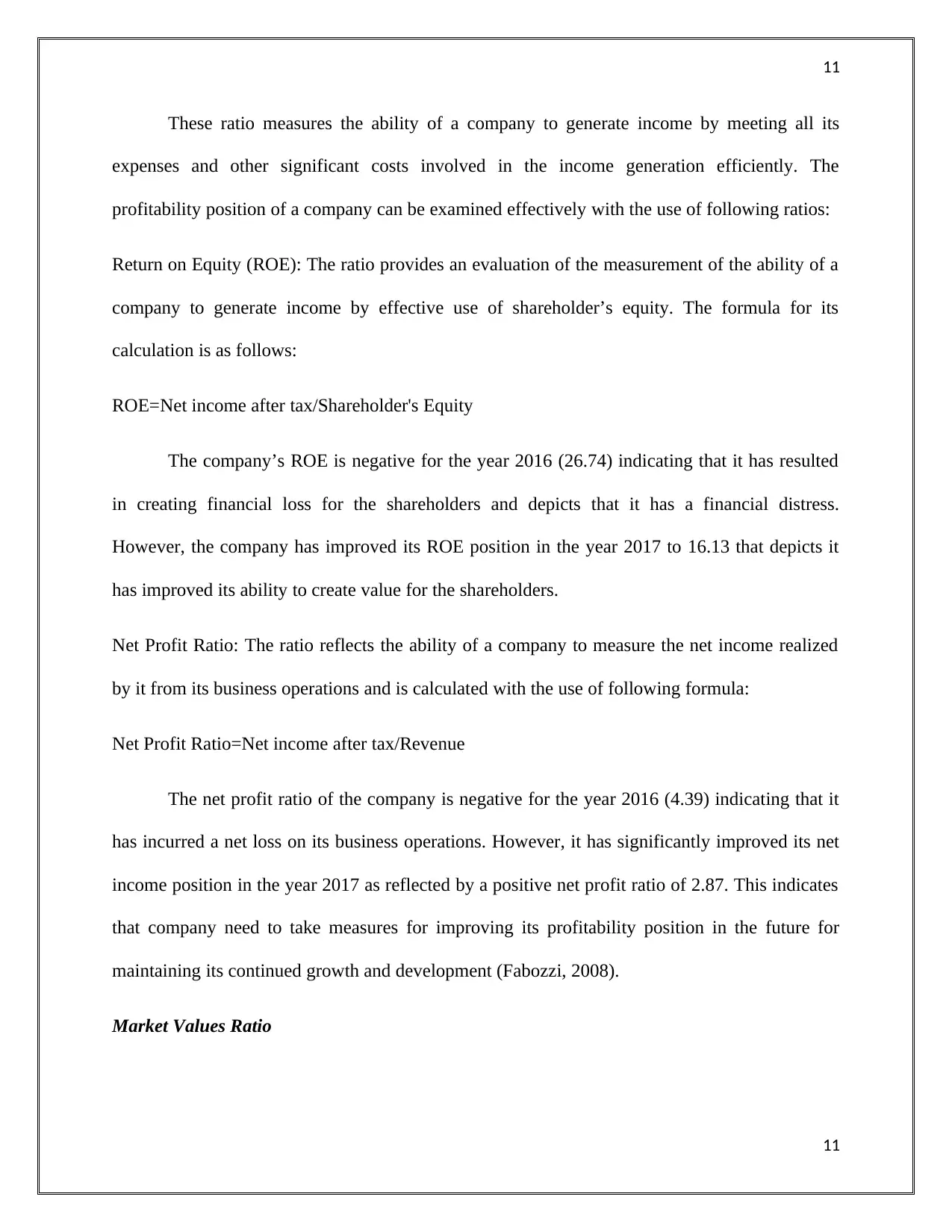
11
These ratio measures the ability of a company to generate income by meeting all its
expenses and other significant costs involved in the income generation efficiently. The
profitability position of a company can be examined effectively with the use of following ratios:
Return on Equity (ROE): The ratio provides an evaluation of the measurement of the ability of a
company to generate income by effective use of shareholder’s equity. The formula for its
calculation is as follows:
ROE=Net income after tax/Shareholder's Equity
The company’s ROE is negative for the year 2016 (26.74) indicating that it has resulted
in creating financial loss for the shareholders and depicts that it has a financial distress.
However, the company has improved its ROE position in the year 2017 to 16.13 that depicts it
has improved its ability to create value for the shareholders.
Net Profit Ratio: The ratio reflects the ability of a company to measure the net income realized
by it from its business operations and is calculated with the use of following formula:
Net Profit Ratio=Net income after tax/Revenue
The net profit ratio of the company is negative for the year 2016 (4.39) indicating that it
has incurred a net loss on its business operations. However, it has significantly improved its net
income position in the year 2017 as reflected by a positive net profit ratio of 2.87. This indicates
that company need to take measures for improving its profitability position in the future for
maintaining its continued growth and development (Fabozzi, 2008).
Market Values Ratio
11
These ratio measures the ability of a company to generate income by meeting all its
expenses and other significant costs involved in the income generation efficiently. The
profitability position of a company can be examined effectively with the use of following ratios:
Return on Equity (ROE): The ratio provides an evaluation of the measurement of the ability of a
company to generate income by effective use of shareholder’s equity. The formula for its
calculation is as follows:
ROE=Net income after tax/Shareholder's Equity
The company’s ROE is negative for the year 2016 (26.74) indicating that it has resulted
in creating financial loss for the shareholders and depicts that it has a financial distress.
However, the company has improved its ROE position in the year 2017 to 16.13 that depicts it
has improved its ability to create value for the shareholders.
Net Profit Ratio: The ratio reflects the ability of a company to measure the net income realized
by it from its business operations and is calculated with the use of following formula:
Net Profit Ratio=Net income after tax/Revenue
The net profit ratio of the company is negative for the year 2016 (4.39) indicating that it
has incurred a net loss on its business operations. However, it has significantly improved its net
income position in the year 2017 as reflected by a positive net profit ratio of 2.87. This indicates
that company need to take measures for improving its profitability position in the future for
maintaining its continued growth and development (Fabozzi, 2008).
Market Values Ratio
11
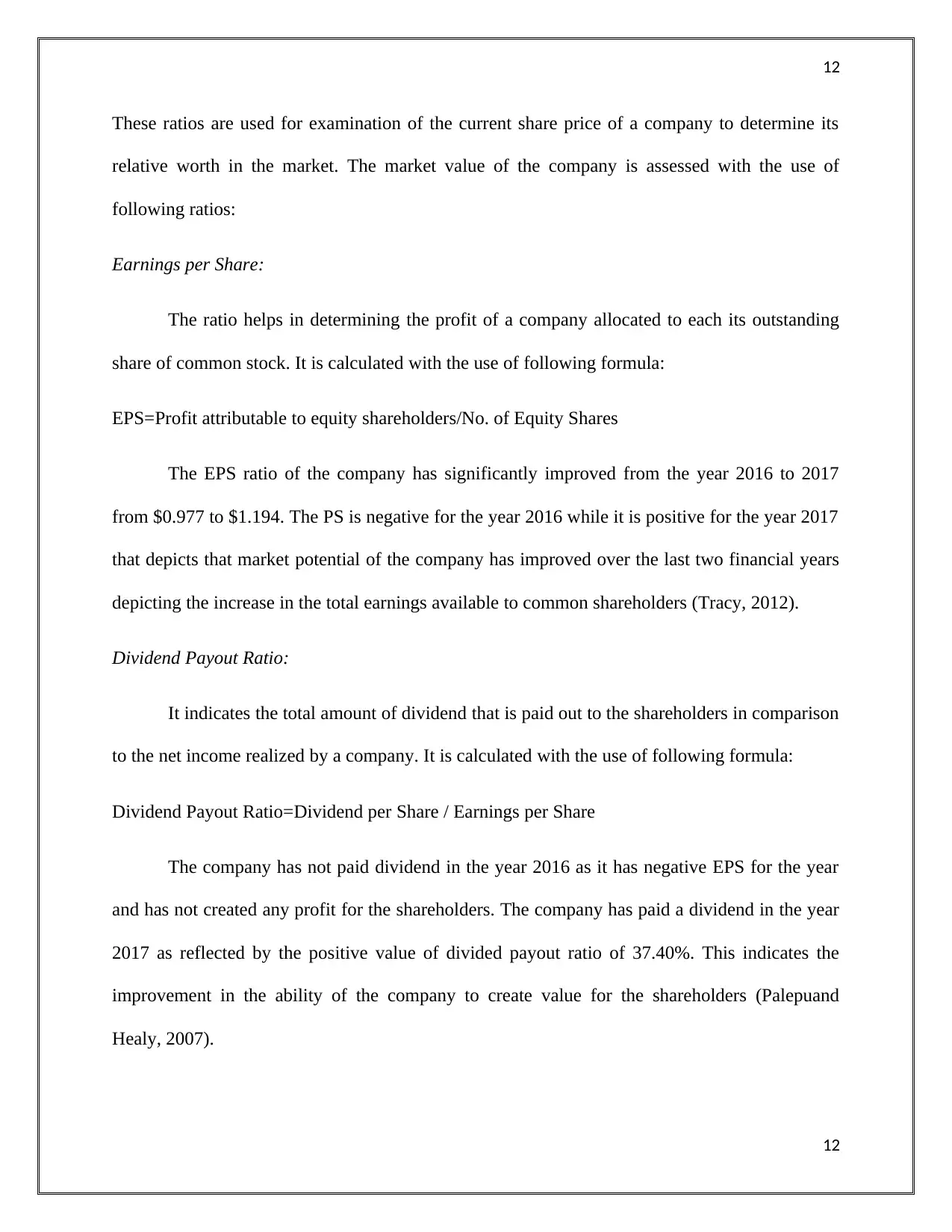
12
These ratios are used for examination of the current share price of a company to determine its
relative worth in the market. The market value of the company is assessed with the use of
following ratios:
Earnings per Share:
The ratio helps in determining the profit of a company allocated to each its outstanding
share of common stock. It is calculated with the use of following formula:
EPS=Profit attributable to equity shareholders/No. of Equity Shares
The EPS ratio of the company has significantly improved from the year 2016 to 2017
from $0.977 to $1.194. The PS is negative for the year 2016 while it is positive for the year 2017
that depicts that market potential of the company has improved over the last two financial years
depicting the increase in the total earnings available to common shareholders (Tracy, 2012).
Dividend Payout Ratio:
It indicates the total amount of dividend that is paid out to the shareholders in comparison
to the net income realized by a company. It is calculated with the use of following formula:
Dividend Payout Ratio=Dividend per Share / Earnings per Share
The company has not paid dividend in the year 2016 as it has negative EPS for the year
and has not created any profit for the shareholders. The company has paid a dividend in the year
2017 as reflected by the positive value of divided payout ratio of 37.40%. This indicates the
improvement in the ability of the company to create value for the shareholders (Palepuand
Healy, 2007).
12
These ratios are used for examination of the current share price of a company to determine its
relative worth in the market. The market value of the company is assessed with the use of
following ratios:
Earnings per Share:
The ratio helps in determining the profit of a company allocated to each its outstanding
share of common stock. It is calculated with the use of following formula:
EPS=Profit attributable to equity shareholders/No. of Equity Shares
The EPS ratio of the company has significantly improved from the year 2016 to 2017
from $0.977 to $1.194. The PS is negative for the year 2016 while it is positive for the year 2017
that depicts that market potential of the company has improved over the last two financial years
depicting the increase in the total earnings available to common shareholders (Tracy, 2012).
Dividend Payout Ratio:
It indicates the total amount of dividend that is paid out to the shareholders in comparison
to the net income realized by a company. It is calculated with the use of following formula:
Dividend Payout Ratio=Dividend per Share / Earnings per Share
The company has not paid dividend in the year 2016 as it has negative EPS for the year
and has not created any profit for the shareholders. The company has paid a dividend in the year
2017 as reflected by the positive value of divided payout ratio of 37.40%. This indicates the
improvement in the ability of the company to create value for the shareholders (Palepuand
Healy, 2007).
12
⊘ This is a preview!⊘
Do you want full access?
Subscribe today to unlock all pages.

Trusted by 1+ million students worldwide
1 out of 18
Related Documents
Your All-in-One AI-Powered Toolkit for Academic Success.
+13062052269
info@desklib.com
Available 24*7 on WhatsApp / Email
![[object Object]](/_next/static/media/star-bottom.7253800d.svg)
Unlock your academic potential
Copyright © 2020–2025 A2Z Services. All Rights Reserved. Developed and managed by ZUCOL.




